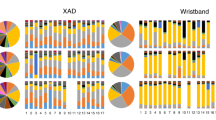Abstract
Dermal contact with sediment is sometimes identified as a pathway of concern in risk assessments. Dermal exposure to sediment is poorly characterized and exposure assessors may rely on default soil adherence values. The purpose of this study was to obtain sediment adherence data for a genuine exposure scenario, child play in a tide flat. This study reports direct measurements of sediment loadings on five body parts (face, forearms, hands, lower legs and feet) after play in a tide flat. Each of nine subjects participated in two timed sessions and pre- and post-activity sediment loading data were collected. Geometric mean (geometric standard deviation) dermal loadings (mg/cm2) on the face, forearm, hands, lower legs and feet for the combined sessions were 0.04 (2.9), 0.17 (3.1), 0.49 (8.2), 0.70 (3.6) and 21 (1.9), respectively. Participants' parents completed questionnaires regarding their child's typical activity patterns during tide flat play, exposure frequency and duration, clothing choices, bathing practices and clothes laundering. Data presented in this paper supplement very limited prior adherence data for sediment contact scenarios. Results will be useful to risk assessors considering exposure scenarios involving child activities at a coastal shoreline or tide flat.
This is a preview of subscription content, access via your institution
Access options
Subscribe to this journal
Receive 6 print issues and online access
$259.00 per year
only $43.17 per issue
Buy this article
- Purchase on Springer Link
- Instant access to full article PDF
Prices may be subject to local taxes which are calculated during checkout



Similar content being viewed by others
References
Adams M.R., Hanna C.A., Mayernik J.A., and Mendez Jr. W.M. Probabilistic health risk assessment for exposures to estuary sediments and biota contaminated with polychlorinated biphenyls, polychlorinated terphenyls and other toxic substances. Risk Anal 1994: 14 (4): 577–593.
Anderson E., Browne N., Duletsky S., et al. Development of statistical distributions or ranges of standard factors used in exposure assessments. NTIS PB85-242667, US Environmental Protection Agency Office of Health and Environmental Assessment, Washington, DC, (1985).
Burgess R., Ryba S., Cantwell M., and Gundersen J. Exploratory analysis of the effects of particulate characteristics on the variation in partitioning of nonpolar organic contaminants to marine sediments. Water Res 2001: 35 (18): 4390–4404.
Dor F., Bonnard R., Gourier-Frery C., Cicolella A., Dujardin R., and Zmirou D. Health risk assessment after decontamination of the beaches polluted by the wrecked Erika tanker. Risk Anal 2003: 23 (6): 1199–1208.
Holmes Jr K.K., Shirai J.H., Richter K.Y., and Kissel J.C. Field measurements of dermal soil loadings in occupational and recreational activities. Environ Res Sect A 1999: 80: 148–157.
Kissel J.C., Richter K.Y., and Fenske R.A. Field measurements of dermal soil loading attributable to various activities: implications for exposure assessment. Risk Anal 1996a: 16 (1): 115–125.
Kissel J.C., Richter K.Y., and Fenske R.A. Factors affecting soil adherence to skin in hand-press trials. Bull Environ Contamin Toxicol 1996b: 56: 722–728.
Kissel J.C., Shirai J.H., Richter K.Y., and Fenske R.A. Investigation of dermal contact with soil in controlled trials. J Soil Contamin 1998: 7 (6): 737–752.
Tetra Tech NUS, Inc.. Human Health Risk Assessment Report for Recreational Use — Old Firefighting Training Area/Katy Field, Naval Station Newport. Draft, May 1999.
Tsang A.M., and Klepeis N.E. Descriptive statistics tables from a detailed analysis of the national human activity pattern survey (NHAPS) data. EPA-600-R-96-148, National Exposure Research Laboratory Office of Research and Development, Las Vegas, NV, 1996.
US EPA. The incidence and severity of sediment contamination in surface water of the United States. EPA-823-R-01-01. National Sediment Quality Survey: Second Edition Draft 2001.
US EPA. Child-specific exposure factors handbook. EPA-600-P-00-002B, National Center for Environmental Assessment, Washington, DC, 2002.
US EPA. Environmental Protection Agency. Contaminated sediments in superfund. Available at: www.epa.gov/superfund/resources/sediment/sites.htmAccessed March 1, 2004a.
US EPA. Risk assessment guidance for superfund. Volume I: Human Health Evaluation Manual (Part E, Supplemental Guidance for Dermal Risk Assessment) Final, EPA-540-R-99-005. July 2004b.
Wang X., Zhang Y., and Chen R. Distribution and partitioning of polycyclic aromatic hydrocarbons (PAHs) in different size fractions in sediments from Boston Harbor, United States. Mar Pollut Bull 2001: 42 (11): 1139–1149.
Wentworth C.K. A scale of grade and class terms for clastic sediments. J Geol 1922: 30: 377–392.
Wong E.Y., Shirai J.H., Garlock T.J., and Kissel J.C. Adult proxy responses to a survey of children's dermal soil contact activities. J Expos Anal Environ Epidemiol 2000: 10: 509–517.
Acknowledgements
We thank Barbara Bergen and Anne Kuhn of EPA's Atlantic Ecology Laboratory for coordinating the field work in Narragansett, RI and Laura Coiro and Saro Jayaraman for assistance with on-site logistics. We also thank the participants and their parents. This project was funded by the EPA through Contract 3W-0017-NATX. This paper reflects the views of the authors and does not necessarily reflect the views of the EPA. No official endorsement should be inferred. The mention of trade names or commercial products constitutes neither endorsement nor recommendation for use.
Author information
Authors and Affiliations
Corresponding author
Rights and permissions
About this article
Cite this article
Shoaf, M., Shirai, J., Kedan, G. et al. Child dermal sediment loads following play in a tide flat. J Expo Sci Environ Epidemiol 15, 407–412 (2005). https://doi.org/10.1038/sj.jea.7500418
Received:
Accepted:
Published:
Issue Date:
DOI: https://doi.org/10.1038/sj.jea.7500418
Keywords
This article is cited by
-
Soil–skin adherence measures from hand press trials in a Gulf study of exposures
Journal of Exposure Science & Environmental Epidemiology (2021)



